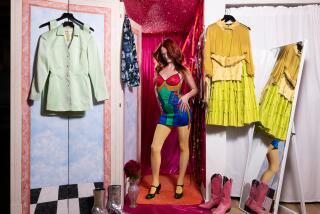DESIGN : Exhibit Examines Art of Packaging a Demand
- Share via
Push a cart down market aisles, read magazine advertising or watch television commercials: No doubt you will find stacks of products proclaimed to be the “newest” or “latest.”
*
This siren call of “progress” has pervaded American society for decades, imploring you to buy, buy, buy.
Even if you may not need to.
Sometimes it’s all so obvious that we are oblivious to it. An exhibit at the Cooper-Hewitt National Museum of Design in New York City, though, uses this idea to take a sharp look at the evolution of 20th-Century American product design and its broader societal implications.
A walk through “Packaging the New: Design and the American Consumer 1925-1975” is a walk through the iconography of America’s recent consumer past.
At the entryway there’s an Art Deco Saks Fifth Avenue store window, circa 1928. From there, displays progress through the years to 1975 by way of:
* A streamlined office;
* A recreation room with pool table, recliner and television;
* A shopping market with such familiar products as Crest toothpaste and Cheer laundry detergent, and grocery carts;
* A 1960s Formica “carousel” kitchen replete with timesaving appliances.
The installation ends with an evolutionary display of toasters--stylistically different, yet functionally the same.
The exhibit looks at the work of five giants of design: Donald Deskey, Norman Bel Geddes, Walter Dorwin Teague, Henry Dreyfuss and Raymond Loewy--Time magazine’s Man of the Year in 1949--and analyzes how they shaped America’s consumer tastes.
But this is more than a display of items most Americans will have no trouble recognizing from their day-to-day lives. It is also a social, economic and environmental commentary, part of Cooper-Hewitt’s mission to “educate all people on the impact of design on our daily lives.”
“We recognize that obsolescence, as practiced by manufacturers and industrial designers, has long been one of the key factors driving our economic system,” says exhibition curator Gail Davidson. “This exhibition questions the value of styling for profit as the chief goal for design, particularly in light of current social and environmental concerns.”
The exhibit explores the design roots behind the proverbial “keeping up with the Joneses.” It chronicles how, in the depth of the Great Depression, industrial designers, advertisers and manufacturers orchestrated economic stimuli using consumer demand driven by style.
It examines how product design, embodied in the nearly 200 items displayed, fueled a burgeoning postwar economy, yet also helped create wasteful consumption based on perceptions of not what is essential, but what is desired.
The designers highlighted in “Packaging the New” helped solve a problem of the 1930s: the Great Depression’s stagnant economy. But, according to the exhibit, they have created a new set of problems and priorities that today’s designers and manufacturers must address.
The focus on a culture of waste created by “old wine in new bottles” brings the exhibit in line with today’s environmental movement, implying that this culture of design helped create Americans’ consumer appetite--the most voracious on earth--which is contributing to the degradation of the global environment.
According to the exhibit, the role of today’s designers is to address the often conflicting priorities of economic growth and environmental protection.
This message brings two levels of interest to the exhibit: You can enjoy looking at objects from an aesthetic or design perspective while pondering the broader implications of designing the new when the old is not necessarily obsolete.
The exhibit is in the stately Carnegie mansion--home to the Cooper-Hewitt--providing irony and contrast: transitory consumer goods displayed in the timeless elegance of the 19th Century mansion’s architecture. This duality is silent yet strong testimony to the sometimes illusory progress the exhibit views with a critical eye.






